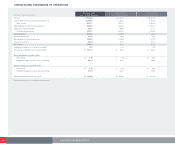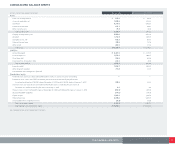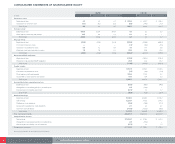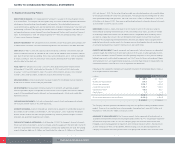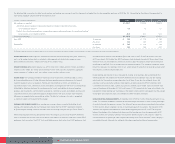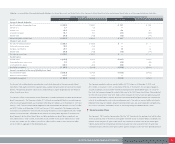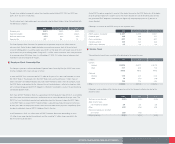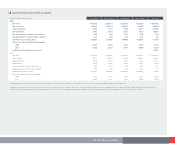CVS 2005 Annual Report Download - page 36
Download and view the complete annual report
Please find page 36 of the 2005 CVS annual report below. You can navigate through the pages in the report by either clicking on the pages listed below, or by using the keyword search tool below to find specific information within the annual report.
34 CVS CORPORATION 2005 ANNUAL REPORT
Intangible assets other than goodwill are required to be separated into two categories: finite-lived and
indefinite-lived. Intangible assets with finite useful lives are amortized over their estimated useful life, while
intangible assets with indefinite useful lives are not amortized. The Company currently has no intangible
assets with indefinite lives.
Following is a summary of the Company’s amortizable intangible assets as of the respective balance sheet dates:
Dec. 31, 2005 Jan. 1, 2005
In millions Gross Carrying Amount Accumulated Amortization Gross Carrying Amount Accumulated Amortization
Customer lists and Covenants not to compete $ 1,152.4 $ (435.9) $ 1,102.8 $ (321.8)
Favorable leases and Other 185.5 (99.8) 173.8 (86.9)
$ 1,337.9 $ (535.7) $ 1,276.6 $ (408.7)
The amortization expense for these intangible assets totaled $128.6 million in 2005, $95.9 million in
2004 and $63.2 million in 2003. The anticipated annual amortization expense for these intangible assets
is $126.1 million in 2006, $119.7 million in 2007, $111.0 million in 2008, $102.7 million in 2009 and
$93.3 million in 2010.
4Borrowing and Credit Agreements
Following is a summary of the Company’s borrowings as of the respective balance sheet dates:
In millions Dec. 31, 2005 Jan. 1, 2005
Commercial paper $253.4 $885.6
5.625% senior notes due 2006 300.0 300.0
3.875% senior notes due 2007 300.0 300.0
4.0% senior notes due 2009 650.0 650.0
4.875% senior notes due 2014 550.0 550.0
8.52% ESOP notes due 2008(1) 114.0 140.9
Mortgage notes payable 21.0 14.8
Capital lease obligations 0.7 0.8
2,189.1 2,842.1
Less:
Short-term debt (253.4) (885.6)
Current portion of long-term debt (341.6) (30.6)
$ 1,594.1 $ 1,925.9
(1) See Note 8 for further information about the Company’s ESOP Plan.
In connection with our commercial paper program, we maintain a $650 million, five-year unsecured back-up
credit facility, which expires on May 21, 2006, and a $675 million, five-year unsecured back-up credit facility,
which expires on June 2, 2010. In addition, we maintain a $675 million, five-year unsecured back-up credit
facility, which expires on June 11, 2009. The credit facilities allow for borrowings at various rates depending
on the Company’s public debt ratings and require the Company to pay a quarterly facility fee of 0.1%,
regardless of usage. As of December 31, 2005, the Company had no outstanding borrowings against the
credit facilities. The weighted average interest rate for short-term debt was 3.3% and 1.8% as of December
31, 2005 and January 1, 2005, respectively.
In September 2004, the Company issued $650 million of 4.0% unsecured senior notes due September 15,
2009 and $550 million of 4.875% unsecured senior notes due September 15, 2014 (collectively the
“Notes”). The Notes pay interest semi-annually and may be redeemed at any time, in whole or in part at a
defined redemption price plus accrued interest. Net proceeds from the Notes were used to repay a portion
of the outstanding commercial paper issued to finance the acquisition of the Acquired Businesses.
To manage a portion of the risk associated with potential changes in market interest rates between the
Company entering into a definitive agreement to purchase the Acquired Businesses and the placement
of the long-term financing, the Company entered into Treasury-Lock Contracts (the “Contracts”) with total
notional amounts of $600 million. The Company settled these Contracts at a loss of $32.8 million during the
third quarter of 2004 in conjunction with the placement of the long-term financing. The Company accounts
for the above derivatives in accordance with SFAS No. 133, “Accounting for Derivative Instruments and
Hedging Activities,” as modified by SFAS No. 138, “Accounting for Derivative Instruments and Certain
Hedging Activities,” which requires the resulting loss to be recorded in shareholders’ equity as a component
of accumulated other comprehensive loss. This unrealized loss will be amortized as a component of interest
expense over the life of the related long-term financing. As of December 31, 2005, the Company had no
freestanding derivatives in place.
The credit facilities and unsecured senior notes contain customary restrictive financial and operating
covenants. The covenants do not materially affect the Company’s financial or operating flexibility.
The aggregate maturities of long-term debt for each of the five years subsequent to December 31, 2005 are
$341.6 million in 2006, $341.9 million in 2007, $45.7 million in 2008, $651.3 million in 2009 and $1.4 million
in 2010.




